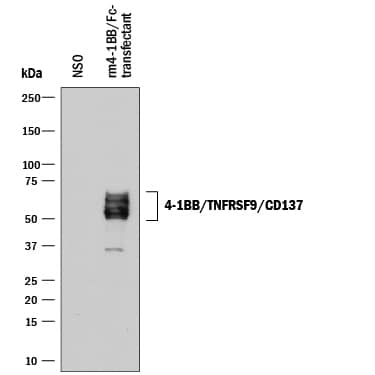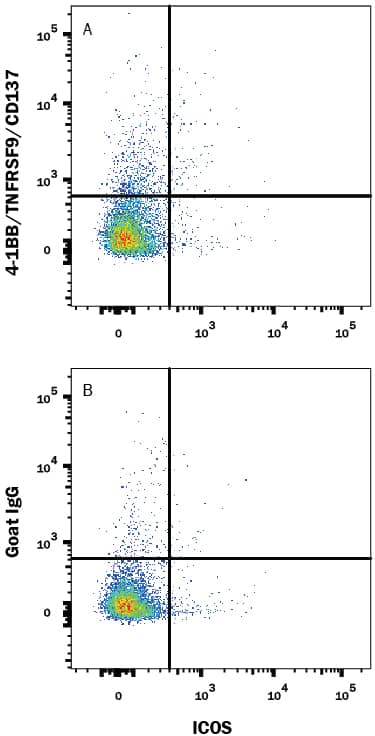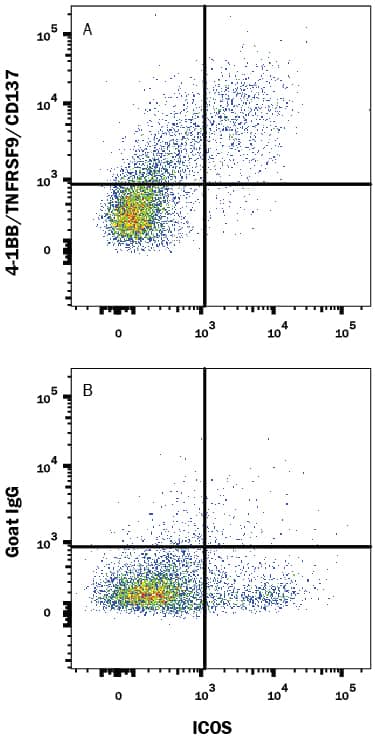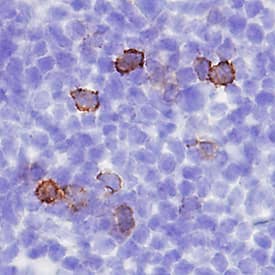Mouse 4-1BB/TNFRSF9/CD137 Antibody
R&D Systems, part of Bio-Techne | Catalog # AF937


Key Product Details
Species Reactivity
Validated:
Cited:
Applications
Validated:
Cited:
Label
Antibody Source
Product Specifications
Immunogen
Val24-Leu187
Accession # P20334
Specificity
Clonality
Host
Isotype
Endotoxin Level
Scientific Data Images for Mouse 4-1BB/TNFRSF9/CD137 Antibody
Detection of Mouse 4‑1BB/TNFRSF9/ CD137 by Western Blot.
Western blot shows lysates of NS0 mouse myeloma cell line either mock transfected or transfected with recombinant mouse 4-1BB/Fc chimera. PVDF membrane was probed with 0.5 µg/mL of Goat Anti-Mouse 4-1BB/TNFRSF9/CD137 Antigen Affinity-purified Polyclonal Antibody (Catalog # AF937) followed by HRP-conjugated Anti-Goat IgG Secondary Antibody (HAF017). Specific bands were detected for 4-1BB/TNFRSF9/CD137 at approximately 50-60 kDa (as indicated). This experiment was conducted under reducing conditions and using Immunoblot Buffer Group 1.Detection of 4‑1BB/TNFRSF9/CD137 in Resting Mouse Splenocytes by Flow Cytometry.
Resting mouse splenocytes were stained with Rat Anti-Mouse ICOS APC-conjugated Monoclonal Antibody (Catalog # FAB168A) and either (A) Goat Anti-Mouse 4-1BB/TNFRSF9/CD137 Antigen Affinity-purified Polyclonal Antibody (Catalog # AF937) or (B) Normal Goat IgG Control (AB-108-C) followed by Phycoerythrin-conjugated Anti-Goat IgG Secondary Antibody (F0107). View our protocol for Staining Membrane-associated Proteins.Detection of 4‑1BB/TNFRSF9/CD137 in Activated Mouse Splenocytes by Flow Cytometry.
Activated mouse splenocytes were stained with Rat Anti-Mouse ICOS APC-conjugated Monoclonal Antibody (Catalog # FAB168A) and either (A) Goat Anti-Mouse 4-1BB/TNFRSF9/CD137 Antigen Affinity-purified Polyclonal Antibody (Catalog # AF937) or (B) Normal Goat IgG Control (AB-108-C) followed by Phycoerythrin-conjugated Anti-Goat IgG Secondary Antibody (F0107). View our protocol for Staining Membrane-associated Proteins.Applications for Mouse 4-1BB/TNFRSF9/CD137 Antibody
Agonist Activity
CyTOF-ready
Flow Cytometry
Sample: Activated and resting mouse splenocytes and NS0 cell line transfected with mouse 4-1BB/TNFRSF9/CD137
Immunohistochemistry
Sample: Perfusion fixed frozen sections of mouse spleen
Western Blot
Sample: NS0 mouse myeloma cell line transfected with recombinant mouse 4-1BB/TNFRSF9/CD137 Fc chimera
Reviewed Applications
Read 1 review rated 4 using AF937 in the following applications:
Formulation, Preparation, and Storage
Purification
Reconstitution
Formulation
*Small pack size (-SP) is supplied either lyophilized or as a 0.2 µm filtered solution in PBS.
Shipping
Stability & Storage
- 12 months from date of receipt, -20 to -70 °C as supplied.
- 1 month, 2 to 8 °C under sterile conditions after reconstitution.
- 6 months, -20 to -70 °C under sterile conditions after reconstitution.
Background: 4-1BB/TNFRSF9/CD137
4-1BB, also known as CD137 and ILA (induced by lymphocyte activation), is a TNF receptor superfamily member and has been designated TNFRSF9. Mouse 4‑1BB cDNA encodes a 256 amino acid (aa) residues type I transmembrane protein with a putative 23 aa signal peptide, a 164 aa extracellular domain, a 21 aa transmembrane domain and a 48 aa cytoplasmic region (1‑3). A soluble 4‑1BB is released from surfaces of cells expressing the transmembrane protein (4).
Mouse 4‑1BB shares approximately 60% aa sequence identity with its human counterpart. 4‑1BB is expressed on activated CD4+ and CD8+ T cells, thymocytes, and NK cells. It is also expressed on monocytes, neutrophils, DCs and eosinophils (5). The ligand for 4‑1BB (4‑1BBL), also named TNFSF9, belongs to the TNF ligand superfamily. 4‑1BBL is predominantly expressed on activated antigen presenting cells (APCs) such as B cells, macrophages and dendritic cells (DCs). It is also expressed on most T and B lymphoma cell lines. In response to 4‑1BBL binding, 4‑1BB transduce a T cell costimulatory signal in both CD4+ and CD8+ T cells to promote survival and enhance proliferation, cytokine production and effector function. In vivo, the costimulatory activity of 4‑1BB has been shown to be important in graft-vs-host disease and antiviral CTL responses. On dendritic cells, 4‑1BB is a DC-activating molecules that enhances cytokine production and up‑regulates expression of B7-1 and B7-2 costimulatory molecules, resulting in an improved ability to stimulate T cell responses (1‑5).
References
- Goodwin, R.G. et al. (1993) Eur. J. Immunol. 23:2631.
- Alderson, M.R. et al. (1994) Eur. J. Immunol. 24:2219.
- Kwon, B.S. and S.M. Weissman (1989) Proc. Nat. Acad. Sci. USA 86:1963.
- Wilcox, R.A. et al. (2002) J. Immunol. 168:4262.
- Kwon, B., H.W. Lee and B.S. Kwon, 2002, TRENDS in Immunology 23:378.
Alternate Names
Gene Symbol
UniProt
Additional 4-1BB/TNFRSF9/CD137 Products
Product Documents for Mouse 4-1BB/TNFRSF9/CD137 Antibody
Product Specific Notices for Mouse 4-1BB/TNFRSF9/CD137 Antibody
For research use only




